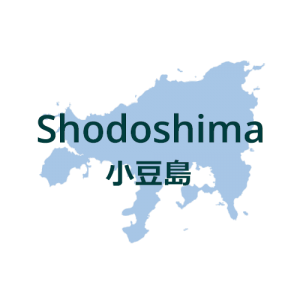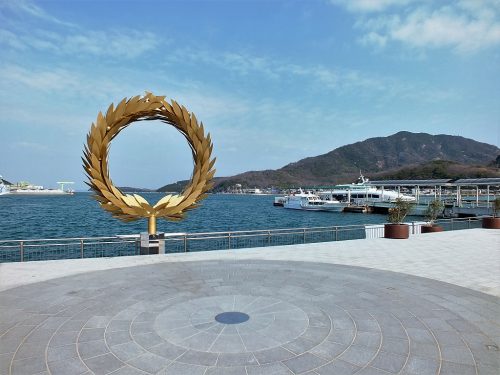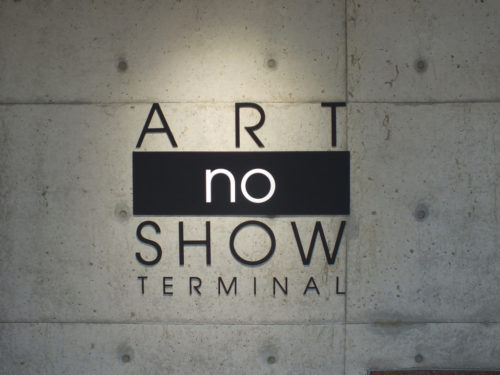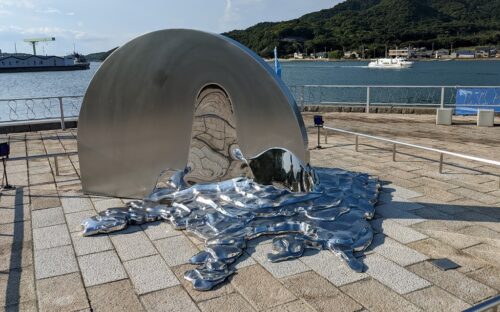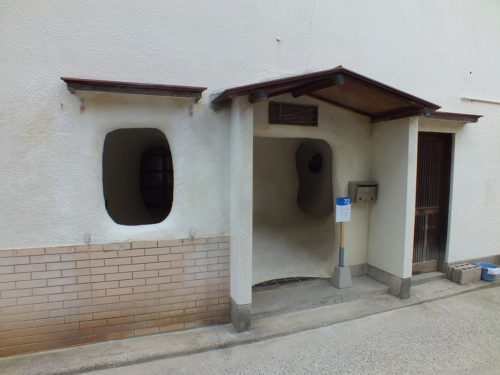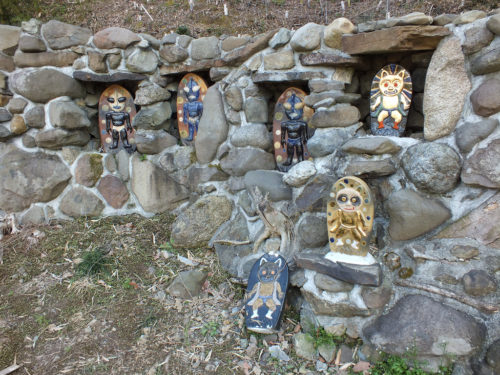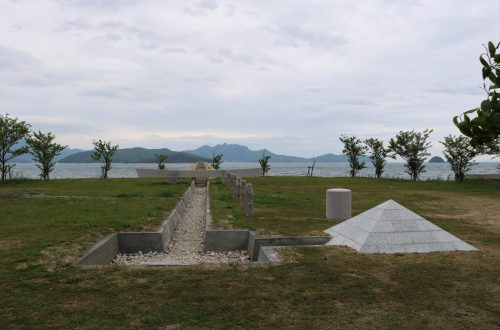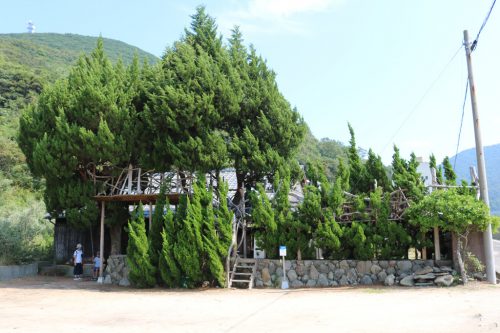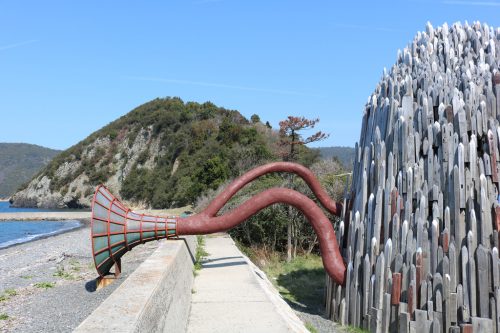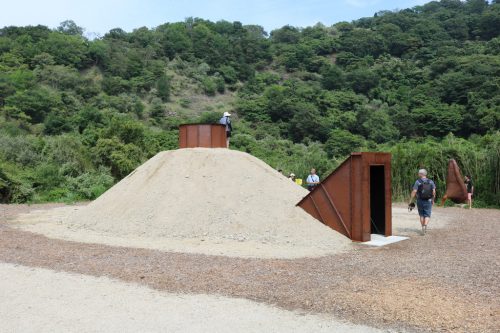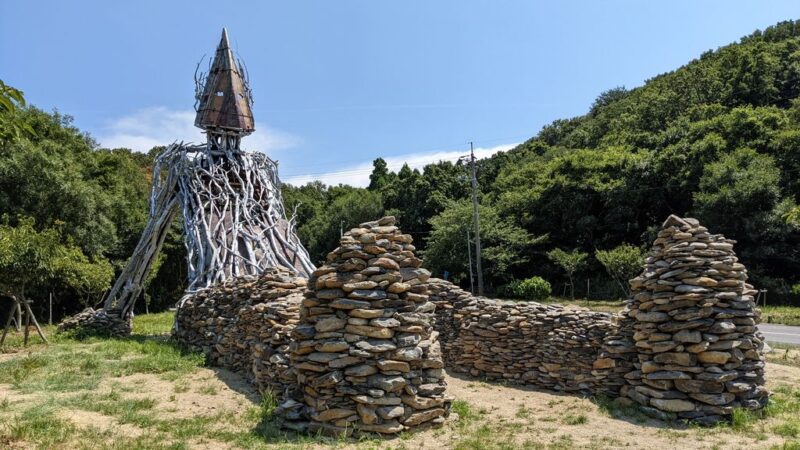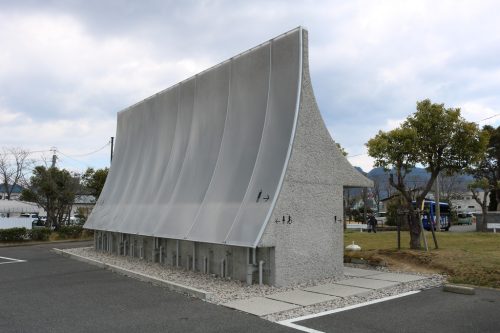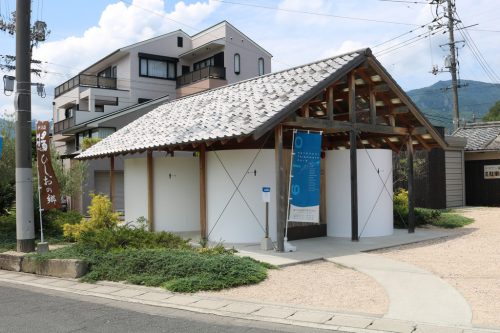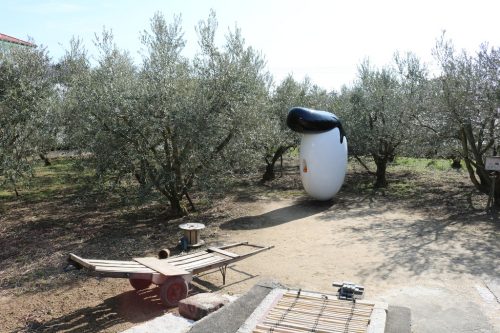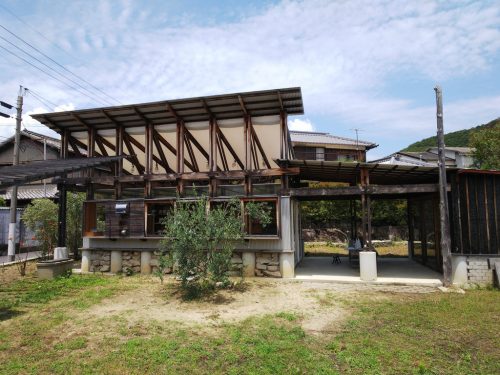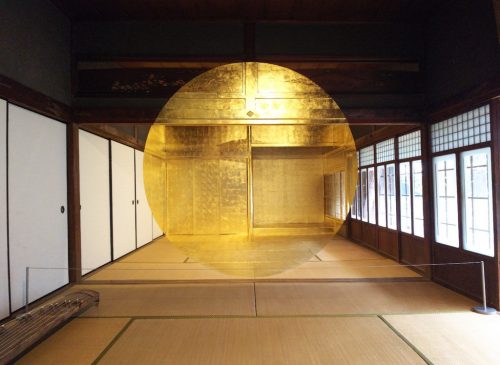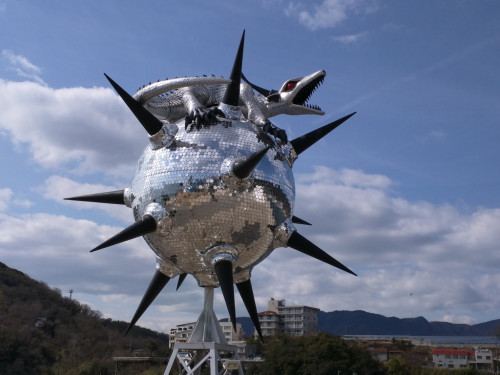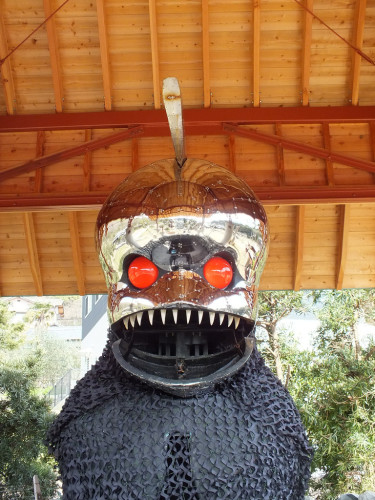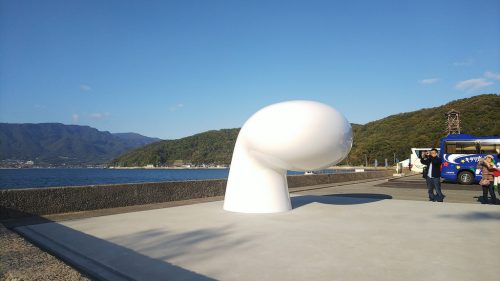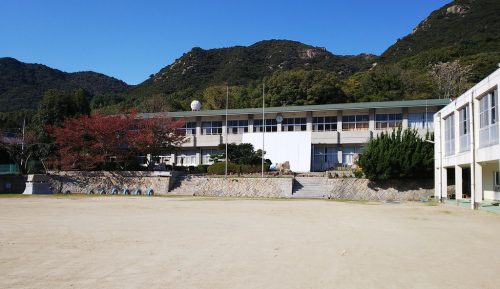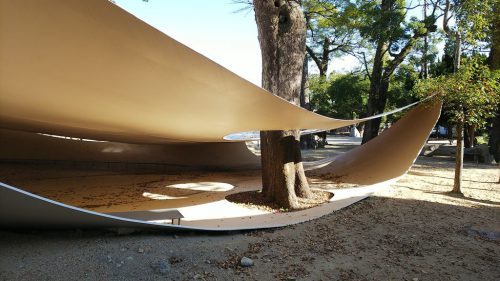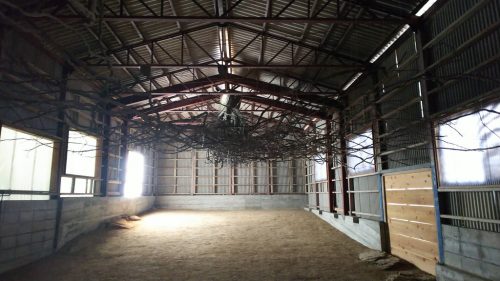Shodoshima is a bit unique among the islands taking part in the Setouchi Triennale. Sure, every island is unique, but if only because of its size Shodoshima feels a little different. It definitely is a little world in itself, with actual towns and more. While it’s mainly famous for being the first and one of the few places where olives can grow in Japan, its economy mostly revolves around the production of soy sauce (some breweries produce some of the best in the country), somen, and tourism (while still relatively unknown overseas, the island has certain notoriety with Japanese tourists because of its amazing landscapes and… well, olives… while they’re somewhat irrelevant in terms of local cuisine, they do attract Japanese tourists always in search of a new edible novelty). However, it is also affected by depopulation, just like the other islands, and its most remote areas (the northern coast, the inner valleys, Mito Peninsula in the south) are seeing their population dropping drastically, just like the rest of the region. So the Setouchi Triennale is needed there too, and thanks to its size, Shodoshima is the island that hosts the largest number of artworks for the art festival.
- Land area: 153.35 square meters
- Circumference: 140.1 km
- Highest Point: 817 m (Mount Hoshigajo)
- Population: around 26,000 residents
Getting There
There are many ferries going to and from Shodoshima.
From Takamatsu, you can easily access two ports: Tonosho (the island’s main port) in the west of the island and Ikeda in the south.
You can also reach Tonosho from Uno Port or Teshima, as well as Shin-Okayama Port and – during the Setouchi Triennale only – Inujima.
You can also arrive on the eastern side of the island from Kobe (Sakate port) or Himeji (Fukuda port) or in the north in Obe port from Hinase in Okayama prefecture.
In other words, you have a lot of choices, even though coming from Takamatsu is probably the easiest and most obvious choice. Also keep in mind that you can arrive in one port and leave from another one, which gives you more leeway when planning your day.
Getting around the island
For better or worse, a car is the best way to get around Shodoshima, especially if you want to see a lot of the art. It is spread out all around the island and various art sites are usually a few kilometers from each other. However, know that bringing a car on the ferry is not cheap, and renting one on the island is a cheaper option if you only spend one day on the island. If you spend more time, bringing your car on the ferry will be cheaper.
If you like riding a bicycle and are quite athletic, it could be the best option though. Shodoshima’s landscapes are stunning, and a bicycle remains the best way to enjoy them, but you’ll need to be in good shape, you will face some steep slopes from time to time. However, the south part of the island is flat(ter) and you can rent electric bikes in Ikeda or Kusakabe ports, and I warmly advise you to do so. Note that you can rent a bike in one port, and leave it in another one.
There are buses that allow access to all the art sites, but know that besides the main road (along the south coast between Tonosho and Sakate) where they’re quite frequent, you will have to plan carefully. If you’re in a remote part of the island and miss the bus, the next one could be a few hours later. There is usually a day bus pass during the Setouchi Triennale.
Finally, Shodoshima is quite popular with local bikers (the one with motor kind), and driving on the semi-mountainous roads of the island must be fun indeed, especially because they have little traffic overall.
Artworks
Usually, outdoor artworks are free and accessible all the time.
Indoor artworks are open only on Triennale days and usually have a 300 yen entrance fee that is covered by the Triennale Passport.
All art sites are free for children and teenagers aged 15 or younger.
Disclaimer: while I try to maintain this page as often as possible, it is possible that some information is inaccurate or out-of-date. As a general reminder, this page is by no means official and is based on my knowledge and experience of the area.
Artworks on Shodoshima
Tonosho Port
sd01
Gift of the Sun
Choi Jeong Hwa (2013)
- Location: Tonosho port, next to the high-speed passenger boat terminal.
- Outdoor artwork, free access
- Choi Jeong Hwa online: official site
- On this site
Review: a very consensual public artwork, but a very pleasant one.
sd02
Art no Show Terminal
Junko Koshino & Atelier Omoya (2016)
- Location: in the passenger terminal for Okayama in Tonosho (the title is a pun)
- Open from 9.30 am to 5.00 pm
- Free entrance
- Junko Koshino online: official site
- On this site
- Hinomaple’s article
Review: During the Setouchi Triennale 2022, the terminal exhibits one of Junko Koshino’s “art dresses.” I have yet to see it.
sd03
Again…
Kim Kyoung-Min (2019)
- Outdoor art
- Free access
- Kim Kyoung-Min online: official site
Review: Interesting. The “leaked” metal represents a map of Shodoshima. The artwork suffers from its location, a bit too out of the way in an area with a lot of transit.
Honmachi (“Downtown” Tonosho)
sd04
Maze Town – Fantasmagoric Alleys
Me (pronounced “meh” affiliated with the Mei Pam Gallery) (2016)
- Location: “Meirocho” that is Tonosho’s historical center, the name of the neighborhood can be translated as “maze neighborhood”
- Open from 9.30 am to 5 pm
- Entrance: 300 yen (the first visit is free with a Triennale Passport)
- Managed by Mei Pam Gallery
Review: I love it, but I won’t tell you what to expect.
sd40
La Dance
Sopheap Pich (2022)
- Location: Honmachi
- Outdoor artwork, free access
- Note: the title is a reference to Matisse’s painting, but unfortunately, the artist made a mistake with his spelling. It should be “La Danse.”
Review: I haven’t seen it yet. I think they’re aluminum trees that look like they’re dancing.
sd41
Together / Friends
Stasys Eidrigevicius (2022)
- Location: Honmachi (two locations)
- Outdoor artwork, free access
Review: I haven’t seen it yet.
sd42
Keep Out
Takefumi Doi (2022)
- Location: Honmachi
- Outdoor artwork, free access
Review: I haven’t seen it yet. From what I understand, it’s simply some chains with “Keep out” signs around places with no special interest. The idea being that the chain and the sign makes gives its interest to the place. I have the feeling this won’t be my cup of tea.
Hitoyama – Nakayama
sd06
Shishigaki Island
Masato Saito (2013, 2016)
- Location: just outside of Hitoyama
- Outdoor artwork, free access
- Hinomaple’s article
Review: Meh…
sd44
Zero
Wang Wen-Chih (2022)
- Location: “One thousand rice fields” in Nakayama
- Open from 9.30 am to 5 pm
- Entrance: 300 yen (the first visit is free with a Triennale Passport)
Review: It is Wang Wen-Chih’s new bamboo house. Always amazing, always one of the artworks not to be missed on Shodoshima during the Setouchi Triennale.
Mito Peninsula
sd10
Garden of the Border
Mitsuharu Doi (2016, 2019)
- Location: village of Kamano (Tanijiri hamlet, south-east of the Mito Peninsula)
- Outdoor artwork, free access
- The artwork has been expanded since 2016
Review: Pretty pleasant land art installation that looks like some sort of archeological site. Pay close attention to the details on the half-buried torii.
sd11
Eyes of Nature (from the Earth)
Julio Goya (2019)
- Location: Just north of Konoura
- Outdoor artwork
- Free entrance
Review: a very fun treehouse.
sd16
Shiomimi-so (Songs of the Tides)
Kana Ko, Toshimitsu Ito and Hiroshima City University Faculty of Arts (2016)
- Location: village of Konoura, on the coast near the south exit of the village
- Outdoor artwork, free access
- Toshimitsu Ito online: official site (in English and Japanese)
- Please note that the artwork will be dismantled at the end of the year.
Review: I really love this building… Is it even a building?… This almost unreal structure whose function is as unreal as its look. I really love when artworks project us into an imaginary world that suddenly becomes tangible.
sd19
Yamagoe-do (Mountain Voice Cavern)
Toshimitsu Ito and Hiroshima City University Faculty of Arts (2019)
- Location: between Konoura and the southern tip of Shodoshima
- Open from 9.30 am to 5 pm
- Free entrance
- Toshimitsu Ito online: official site (in English and Japanese)
Review: more or less a follow-up to Shiomimi-so. I like the idea and the structure, unfortunately, it doesn’t “work” too great (the echo in the chamber is very strong and one doesn’t hear much of the outside). Still an interesting creation.
sd45
Human Home Hermit Crab
Daisuke Omi (2022)
- Location: Konoura, in the Western part of the village, near Shiomimi-so
Review: A giant wooden hermit crab has finally found a house that fits and it’s awesome.
sd46
Daidaraurutorabou
Toshimitsu Ito and Hiroshima City University Faculty of Arts (2022)
- Location: just before arriving in Konoura
- Outdoor outwork, free access
- Toshimitsu Ito online: official site (in English and Japanese, but doesn’t seem to have been updated in quite a while)
- On the blog: Daidaraurutorabou
Review: A pretty neat giant welcoming you when you arrive at Konoura.
sd47
Popstop
Charles Worthen (2022)
- Location: the bus stop near Shiomimi-so in the Western part of Konoura
- Outdoor outwork, free access
Review: Does it make the bus stop look nicer? Yes, it does. However, while it definitely makes the place nicer looking, I have a hard time seeing this piece as a “Setouchi Triennale” artwork, just some wall decoration, basically.
Note that “Dancing Alone” an old artwork from Charles Worthen that was part of the Triennale in 2016 is still around in the neighborhood (it’s basically a ready-made from a tetrapod)
sd48
Story of a Boat
Julio Goya (2022)
- Location: just before arriving in Konoura, just next to the “sitting giant”
- Outdoor outwork, free access
- Julio Goya’s blog (in Japanese)
Review: It’s OK, but nothing too amazing.
sd49
Utopia dungeon ~ Command from Utopia ~
Keisuke Tanaka (2022)
- Location: inside the village of Konoura
Review: Keisuke Tanaka reuses the same building as he used in 2019, the “Utopia dungeon” but has installed new wooden sculptures. I liked it much better in 2019, unfortunately.
Hishionosato
(Kusakabe, Yasuda, Umaki, Noma)
sd21
Stone Island’s Stone
Hideyuki Nakayama (2016)
- Location: Kusakabe Port
- Outdoor artwork, free access
- It’s a public toilet
- Hideyuki Nakayama online: official site, Twitter, Instagram
Review: Maybe I need the opinion of an architect, but I don’t really have an opinion on the building either way. It serves its purpose though.
sd24
Hut with Arc Wall
Architect: Yo Shimada (2013)
- Location: Umaki
- Outdoor artwork, free access
- It’s a public toilet
- Yo Shimada online: official site, Twitter
- Hinomaple’s article
Review: I really love this building that’s a little confusing at first, like a very tiny maze. As it’s a toilet, one may have the feeling that it lacks privacy, but fear not, it’s part of the point I assume, and you’ll be fine.
sd25
Regent in Olives
Hisakazu Shimizu (2013)
- Location: Umaki
- Outdoor artwork, free access
- On this site
- Hinomaple’s article
Review: I can’t not find it silly, but I kinda love it at the same time.
sd26
Umaki Camp
Architecture: Dot Architects (Toshikatsu Ienari, Takeshi Shakushiro, Tatsuya Mukai) – Project director: Noboru Tsubaki (2013)
- Location: Umaki
- Open from 9.30 am to 5 pm
- Dot Architects online: official site
- Hinomaple’s article
Review: I really love this somewhat utopian space. A place for everyone: a kitchen, a garden and more, for all to use. A place where visitors can rest, meet other visitors or locals. If there were more places like this in the world, it would be a better place, I mean it.
Unfortunately, I must add that if this is what it was in 2013 when it was new, nowadays, locals don’t seem to be using it much and some parts need to be better taken care of. The kitchen is still great, and I make sure to have lunch there almost every time I come to Umaki.
sd27
Georges Gallery
Georges Rousse, Yasushi Kishimoto, Takashi Tochiyama, Miyabi Katayama (2019)
- Location: Umaki
- Open from 9.30 am to 5 pm
- Entrance: 500 yen (300 yen with a Triennale Passport)
- Georges Rousse online: official site, Facebook
Review: The artworks are quite interesting, even though they almost look better on pictures than for real. I have mixed feelings about the place itself (the gallery and café). It feels like it belongs to a fancy and upscale city, not Umaki that is quite rural. In other words, it really feels out of place.
sd27
Hishio no Sato Museum of Contemporary Art (MOCA)
Keiji Uematsu, Nobuko Watanabe, Yoshinobu Nakagawa (2022)
Planning: Shodoshima Art Project
Design: Dot Architects
- Location: Umaki, in the former soy sauce cooperative building (that has hosted artworks for the Triennale since 2013)
- Open from 10 am to 5 pm
- Entrance fee: 1,500 yen
Review: If I understand correctly, the place has been turned into an actual and permanent museum from this year. I’ll tell you more as soon as I’ve seen it.
sd50
The Shore where we can reach
Xiang Yang (2022)
- Location: Kusakabe Port
- Open from 9.30 am to 5 pm
- Entrance: 300 yen (the first visit is free with a Triennale Passport)
- Discovering “The Shore where we can reach 2022” on Youtube
- Xiang Yang on Setouchi Explorer
Review: When Xiang Yang came to Shodoshima in 2019, his wonderful installation The shore where we can reach was supposed to be the first step of a much larger future project. Well, this is the much larger project and it’s amazing. One of the artworks not to miss this year.
Sakate
sd30
Star Anger
Kenji Yanobe (2013)
- Location: Sakate Port
- Outdoor artwork, free access
- Kenji Yanobe online: official site
- Hinmaple’s article
Review: I’m a fan, both of the statue and Legend of Shodoshima the mural that was painted right next door.
sd31
Beat Shrine / Anger from the Bottom
“Beat” Takeshi Kitano et Kenji Yanobe (2013)
Building by Dot Architects (2014)
- Location: Sakate
- Outdoor artwork, free access
- Kenji Yanobe online: official site
- Dot Architects online: official site
- Read the latest blog post about Anger from the Bottom
Review: I love this “god of anger” that’s terrifying and cute.
sd51
Shodoshima House Project
(2022)
- Location: village of Sakate
Review: I haven’t seen it yet, and I’m not totally sure what it is about.
Tanoura
sd32
Fisherman’s Dream
Saya Irie (2019)
- Location: 24 Eyes Movie Village
- Open from 9 am to 5 pm
- Entrance: 790 yen (it’s the entrance fee for the Movie Village – 500 yen with the Triennale Passport)
Review: I haven’t seen it yet.
sd33
Bollard of Love
Hisakazu Shimizu (2016)
- Location: in front of the 24 Eyes Movie Village
- Outdoor artwork, free access
Review: Meh.
Fukuda
sd34-B
Fukutake House – Asia Art Platform
(2013)
- Location: Fukuda’s former school
- Open from 11 am to 5 pm
- Entrance: 500 yen (the first visit is free with the Triennale Passport)
- Managed by Benesse Art Site Naoshima
Review: It houses various temporary exhibits.
sd35
Fukita Pavilion
Ryue Nishizawa (2013)
- Location: between Fukutake House and the Hachiman shrine nearby
- Outdoor artwork, free access
- Ryue Nishizawa online: official site
- Read the latest blog post about Fukita Pavilion
Review: It makes me think of two giant sheets of paper that would have been forgotten there, and now we can hide in between them.
Obe
Shodoshima Tree (closed)
Kohei Takekoshi (2016)
- Location: village of Obe
- Open from 9.30 am to 5 pm
- Entrance: 300 yen (the first visit is free with the Triennale Passport)
Review: Very interesting. We feel like we’re underground – if the ground was invisible.
Kitaura
sd38
Dynamite Traverse Variations
Chichibu Avant-Garde (2016)
- Location: Osakajo Zanseki Kinen Koen
- Open from 9.30 am to 5 pm
- Free entrance
Review: It’s a musical installation with some avant-garde music. I don’t really have a strong opinion about it.
